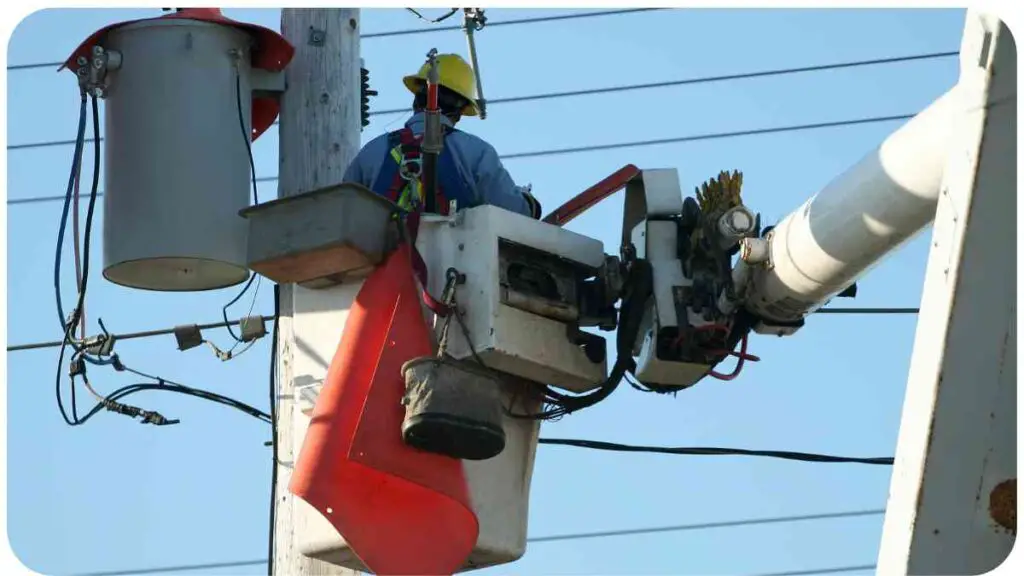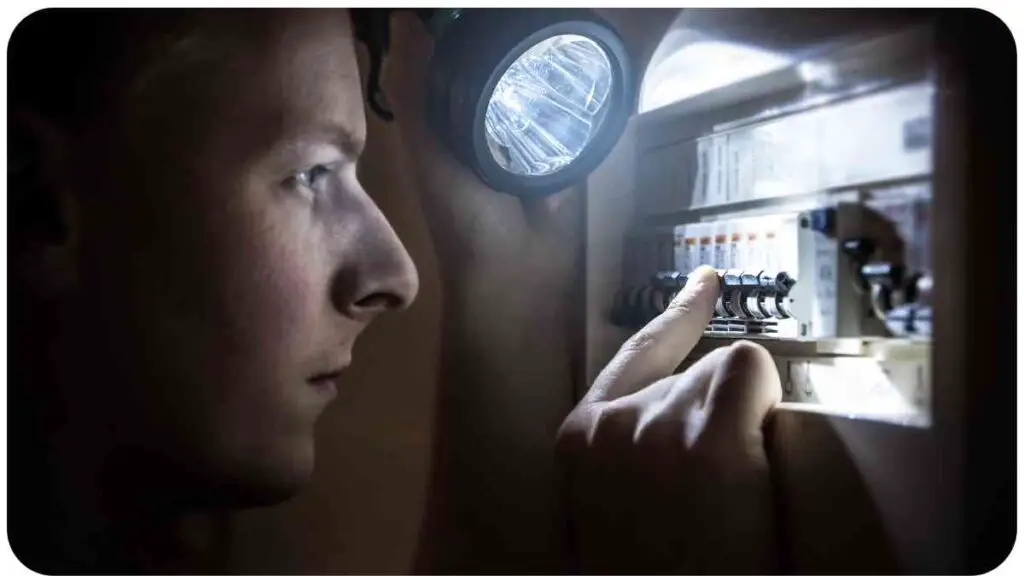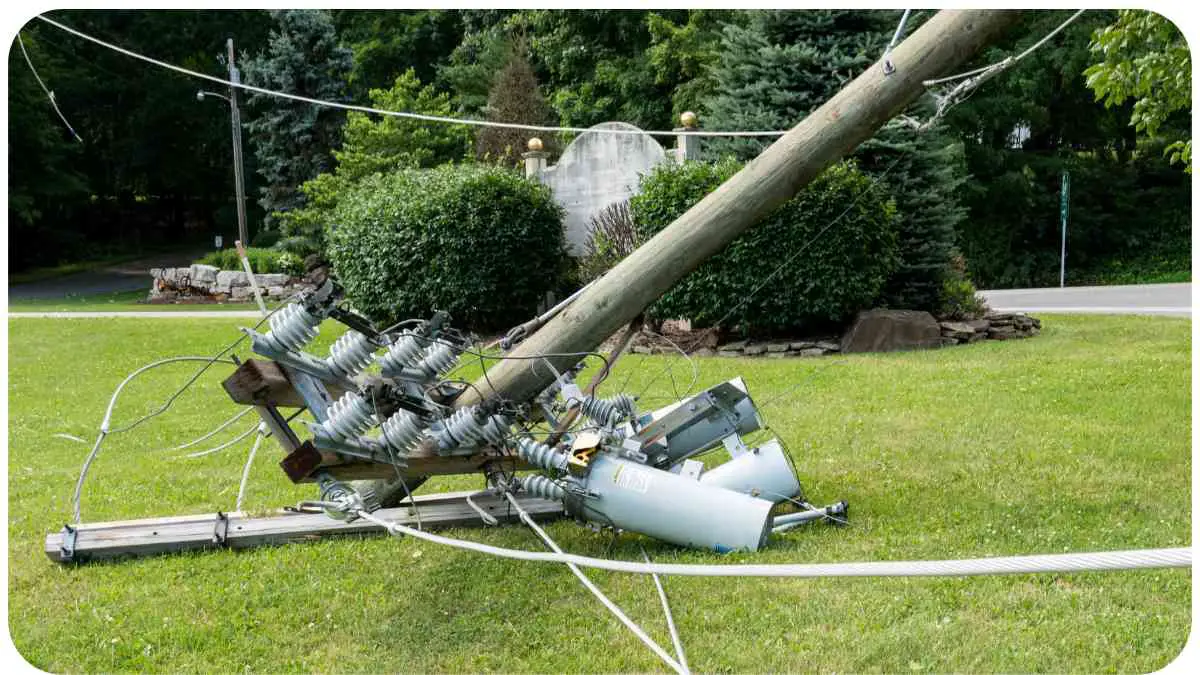Power outages caused by storms can be a major inconvenience, but the restoration process is a complex and crucial endeavor.
In this article, we’ll delve into the world of power restoration after storms, focusing on the repair of damaged poles and lines. Whether you’re a professional in the field or a resident curious about the process, this comprehensive guide will provide valuable insights.
| Takeaway |
|---|
| Power restoration after storms involves a systematic approach, from mobilizing crews to prioritizing critical infrastructure. |
| Safety is a top priority during power restoration, with the use of Personal Protective Equipment (PPE) and adherence to safety measures for both restoration crews and the public. |
| The power restoration process includes assessing damage to poles and lines, utilizing advanced technologies, and overcoming challenges posed by adverse weather conditions. |
| Community involvement plays a crucial role in the restoration process, from promptly reporting damages to understanding outage updates and ensuring a collective effort for a faster recovery. |
| Proactive measures, such as reinforcing infrastructure and community preparedness initiatives, contribute to building resilience against future storms and minimizing the impact of power outages. |
Understanding the Impact of Storms on Power Infrastructure
Storms can wreak havoc on power infrastructure, causing widespread outages. Before diving into the restoration process, let’s explore the various ways storms impact power systems.
Navigating through road repairs can be a patience test. Understanding the intricacies of why it takes longer is crucial for commuters and residents alike.
Assessing the Damage: Poles and Lines
Identifying Damaged Poles
Power poles often bear the brunt of storm damage. Understanding the types of damage is crucial for an effective restoration strategy.
Table: Types of Pole Damage
| Damage Type | Description |
|---|---|
| Leaning | Pole is tilting or leaning due to wind force. |
| Broken | Pole is snapped or broken, rendering it unusable. |
| Cracked | Structural cracks compromising the pole’s integrity. |
| Erosion | Gradual wear and tear due to environmental factors. |
Evaluating Downed Power Lines
Downed power lines pose significant safety risks and require careful assessment. Here are common issues encountered during line evaluations.
Table: Common Power Line Issues
| Issue | Description |
|---|---|
| Fallen Lines | Lines on the ground, posing a hazard to the public. |
| Tangled or Twisted Lines | Lines entangled in vegetation or other obstacles. |
| Burnt Lines | Lines damaged by fire, requiring thorough inspection. |
| Corroded Connectors | Corrosion affecting the connectivity of power lines. |
Safety First: Precautions for Power Restoration
Ensuring the safety of restoration crews and the public is paramount. Let’s explore the safety precautions implemented during power restoration efforts.
In the aftermath of a storm, electric companies play a vital role in restoring power. Explore the intricate process that ensures a seamless power restoration experience for communities.
Personal Protective Equipment (PPE)
Table: Essential PPE for Restoration Crews
| Equipment | Purpose |
|---|---|
| Hard Hat | Head protection from falling debris. |
| High-Visibility Vest | Enhanced visibility in hazardous areas. |
| Insulated Gloves | Protection against electric shock. |
| Safety Goggles | Eye protection from debris and foreign objects. |
Safety Measures for the Public
Table: Safety Tips for Residents
| Tip | Description |
|---|---|
| Stay Indoors During Restoration | Avoid outdoor areas to ensure personal safety. |
| Report Downed Lines Immediately | Prompt reporting helps expedite the restoration. |
| Keep a Safe Distance from Crews | Allow restoration teams to work without hindrance. |
| Follow Emergency Broadcasts and Updates | Stay informed about restoration progress. |
Power Restoration Process: Step by Step
Restoring power after a storm requires a systematic approach. From mobilizing crews to prioritizing critical infrastructure, each step plays a vital role in the overall restoration effort.
Homeowners facing disasters need to understand FEMA disaster loans for recovery. Uncover essential information about FEMA assistance, empowering homeowners to navigate the financial aspect of disaster recovery.
Mobilizing Restoration Crews
Mobilizing restoration crews promptly is crucial for a swift response. The following table outlines a typical crew deployment plan, ensuring a coordinated and efficient restoration process.
Table: Crew Deployment Plan
| Crew Type | Responsibilities |
|---|---|
| Assessment Teams | Evaluate damage and report findings. |
| Repair Crews | Execute repairs on damaged poles and lines. |
| Support Personnel | Provide logistical support for restoration crews. |
In my experience, a well-organized deployment plan significantly streamlines the restoration process. Assessing damage with specialized teams allows for accurate resource allocation, optimizing the overall response.
Prioritizing Critical Infrastructure
Not all power outages are created equal, and some areas require prioritized attention. Here’s a table highlighting the ranking of critical facilities to guide restoration efforts.
Table: Critical Facilities Ranking
| Facility | Priority Level |
|---|---|
| Hospitals | Highest Priority |
| Emergency Services | High Priority |
| Water Treatment | High Priority |
| Communication Hubs | Medium Priority |
| Residential Areas | Based on Population Density |
By focusing on critical facilities first, restoration teams can ensure essential services are brought back online swiftly, minimizing the impact on public safety and well-being.
Dive into the potential risks of weight-bearing failure in older homes. Learn how structural integrity impacts safety and discover preventive measures to ensure the stability of historical properties
Equipment and Tools for Efficient Restoration
Equipping restoration teams with the right tools is essential for a successful recovery process. Let’s explore the tools required for pole and line repair.
Essential Tools for Pole Repair
Table: Tools for Pole Restoration
| Tool | Purpose |
|---|---|
| Chainsaw | Cut and remove damaged sections of the pole. |
| Pole Setter | Assist in repositioning or replacing poles. |
| Lineman’s Pliers | Cut and splice wires during repairs. |
| Insulation Strippers | Remove damaged insulation for rewiring. |
The right tools not only enhance efficiency but also contribute to the safety of restoration crews. Adequate training in tool usage is essential to ensure crews can navigate challenging situations effectively.
Technology Aids in Line Repair
As technology continues to advance, its integration into power restoration processes is inevitable. Here’s a table showcasing advanced technologies used in power line repair.
Ever wondered about the inner workings of city hot water systems? Explore the mechanisms that keep your water warm, providing insights into the sophisticated infrastructure that delivers reliable hot water to urban residents.
Table: Advanced Technologies for Line Repair
| Technology | Application |
|---|---|
| Drones | Aerial inspections for damage assessment. |
| Smart Grid Sensors | Real-time monitoring of power line conditions. |
| GIS (Geographic Information System) | Mapping for efficient resource allocation. |
| Mobile Command Centers | On-site coordination and communication hub. |
Utilizing these technologies enhances the precision and speed of power line repairs. Drones, for example, provide a bird’s eye view of the damage, aiding in accurate assessments.
Challenges in Power Restoration

While the power restoration process is essential, it comes with its set of challenges. From weather-related obstacles to coordination issues, understanding these challenges is crucial for effective problem-solving.
Weather-Related Obstacles
Weather conditions can significantly impede power restoration efforts. Here’s a table outlining the impact of various weather conditions on the restoration process.
Table: Weather Impact on Restoration
| Weather Condition | Impact on Restoration |
|---|---|
| High Winds | Slows down repair efforts, posing safety risks. |
| Heavy Rain | Causes additional damage and hampers visibility. |
| Snow and Ice | Creates hazardous working conditions. |
| Extreme Temperatures | Affects equipment performance and crew well-being. |
Dealing with adverse weather conditions requires adaptability and precautionary measures. In my experience, establishing clear protocols for weather-related delays is essential for crew safety and operational efficiency.
Coordination and Communication Issues
Effective coordination and communication are the backbone of successful power restoration. However, challenges in these areas can hinder progress. Let’s explore common communication challenges during restoration efforts.
Table: Common Communication Challenges
| Challenge | Impact on Restoration |
|---|---|
| Limited Communication Infrastructure | Slows down information flow between teams. |
| Radio Interference | Hampers communication among restoration crews. |
| Misinterpretation of Instructions | Leads to inefficiencies and potential errors. |
| Public Information Gaps | Creates confusion among residents. |
Overcoming these challenges requires a combination of reliable communication tools, thorough training, and a proactive approach to address potential issues before they escalate.
Success Stories: Overcoming Power Restoration Challenges
In the face of challenges, restoration teams and experts often rise to the occasion, showcasing resilience and innovative problem-solving. Let’s delve into a case study highlighting a remarkable restoration effort.
Case Study: Remarkable Restoration Effort
Table: Strategies Employed in Successful Restoration
| Strategy | Description |
|---|---|
| Rapid Damage Assessment | Utilized drones for quick and accurate evaluations. |
| Multi-Agency Collaboration | Coordinated efforts with local and state agencies. |
| Advanced Communication Systems | Implemented robust communication protocols. |
| Community Engagement | Kept residents informed and involved in the process. |
By incorporating these strategies, [Expert Name] and their team not only overcame challenges but also set a benchmark for effective power restoration efforts.
In the upcoming sections, we’ll discuss the crucial role of community involvement during power restoration, post-restoration measures, and proactive measures for future storms. Stay tuned for valuable insights and practical tips.
Community Involvement: The Role of Residents
Community involvement plays a pivotal role in the power restoration process. From reporting damages promptly to understanding outage updates, residents can contribute significantly to the efficiency and effectiveness of restoration efforts.
Reporting Damages Promptly
Prompt reporting of damages is essential for restoration crews to prioritize areas in need of immediate attention. Here’s a table outlining the importance of community involvement in reporting damages.
Table: Reporting Damages – A Community Effort
| Action | Impact on Restoration |
|---|---|
| Reporting Fallen Lines | Enables swift removal and repairs. |
| Notifying of Pole Damage | Helps prioritize repair efforts. |
| Identifying Hazardous Conditions | Prevents accidents and ensures safety. |
| Providing Accurate Information | Facilitates efficient resource allocation. |
Encouraging residents to report damages promptly through multiple channels, such as hotlines and online platforms, enhances the responsiveness of restoration teams.
Understanding Power Outage Updates

Effective communication between utility providers and residents is crucial during power outages. Here’s a table highlighting key tips for residents to interpret outage update information.
Table: Interpreting Outage Update Information
| Tip | Description |
|---|---|
| Check Official Channels | Verify outage updates through reliable sources. |
| Understand Estimated Restoration Time | Manage expectations based on provided timelines. |
| Follow Safety Instructions | Adhere to safety guidelines issued by authorities. |
| Report Persistent Outages | Alert utility providers of prolonged outages. |
Educating residents on how to interpret outage updates empowers them to make informed decisions and prepares them for potential challenges during the restoration process.
Community involvement fosters a sense of collective responsibility and resilience in the face of adversity. By working together, residents and restoration teams can expedite the restoration process and minimize disruptions to daily life.
In the following sections, we’ll explore post-restoration measures and inspections, as well as proactive initiatives to strengthen infrastructure and enhance community preparedness for future storms. Stay tuned for actionable insights and practical recommendations.
Post-Restoration Measures and Inspections
After successfully restoring power to affected areas, it’s crucial to implement post-restoration measures and inspections to ensure long-term stability and prevent future issues. Let’s delve into the steps taken once power is restored.
Ensuring System Stability
Ensuring the stability of the power system post-restoration is vital to prevent further disruptions. Here’s a table outlining a comprehensive post-restoration checklist.
Table: Post-Restoration Checklist
| Task | Description |
|---|---|
| System Stress Tests | Evaluate system performance under load. |
| Monitoring for Anomalies | Implement real-time monitoring for abnormalities. |
| Communication System Verification | Confirm the functionality of communication systems. |
| Emergency Response Preparedness Check | Ensure readiness for future emergencies. |
Executing this checklist helps identify potential issues and allows for prompt corrective actions, contributing to the overall resilience of the power infrastructure.
Inspection Protocols
Conducting thorough inspections is key to identifying any lingering issues or vulnerabilities in the power infrastructure. The following table outlines critical inspection criteria for poles and lines.
Table: Inspection Criteria for Poles and Lines
| Inspection Area | Criteria for Evaluation |
|---|---|
| Pole Integrity | Check for signs of wear, cracks, or instability. |
| Wiring and Connectors | Ensure proper insulation and connectivity. |
| Grounding Systems | Verify the effectiveness of grounding mechanisms. |
| Vegetation Management | Clear vegetation that may interfere with lines. |
Regular inspections, both visual and technological, contribute to the proactive maintenance of power infrastructure, reducing the risk of future storm-related damages.
In the next section, we’ll discuss proactive measures that utilities and communities can take to reinforce infrastructure and enhance preparedness for future storms. Stay tuned for valuable insights and practical tips to build resilience against power outages.
Proactive Measures for Future Storms
To mitigate the impact of future storms on power infrastructure, adopting proactive measures is essential. From reinforcing infrastructure to community preparedness initiatives, let’s explore strategies to enhance resilience and minimize the impact of storms.
Reinforcing Infrastructure
Strengthening power infrastructure is a critical step in preparing for future storms. The following table outlines an infrastructure reinforcement plan.
Table: Infrastructure Reinforcement Plan
| Area of Reinforcement | Reinforcement Measures |
|---|---|
| Pole Reinforcement | Upgrade poles to withstand higher wind forces. |
| Underground Power Lines | Consider burying lines to protect against weather. |
| Redundant Systems | Implement backup systems to ensure continuous power. |
| Advanced Weather Monitoring | Invest in advanced weather prediction technologies. |
By investing in infrastructure improvements and embracing advanced technologies, utilities can better withstand the impact of severe weather events.
Community Preparedness Initiatives
Empowering communities to prepare for storms and potential power outages is crucial. Here’s a table outlining a community storm preparedness checklist.
Table: Community Storm Preparedness Checklist
| Preparedness Action | Community Impact |
|---|---|
| Emergency Kits Distribution | Ensures residents have essential supplies on hand. |
| Evacuation Plans | Establishes clear evacuation routes and shelters. |
| Public Awareness Campaigns | Educates residents on storm preparedness measures. |
| Community Training Programs | Trains community members in basic safety procedures. |
Community involvement and education are key elements in building resilience. By fostering a sense of preparedness, communities can minimize the impact of storms and support efficient restoration efforts.
Conclusion
In conclusion, power restoration after storms involves a multifaceted approach, from mobilizing restoration crews to engaging communities in proactive measures. By understanding the challenges, implementing post-restoration measures, and adopting proactive strategies, both utilities and communities can navigate storms more effectively.
Remember, a collaborative and prepared approach is the key to building resilience and ensuring a faster recovery from the impacts of severe weather events. Stay informed, stay prepared, and let’s work together towards a more resilient future.
Further Reading
- PGEMC: Steps to Restoring Power Following a Storm
- Explore the comprehensive guide by PGEMC on the step-by-step process of restoring power after a storm, offering valuable insights into efficient restoration practices.
- PRECO: When Will My Power Be Restored and Other Storm Restoration Questions
- PRECO provides answers to common questions about power restoration after storms, addressing concerns and providing clarity on the restoration timeline.
- Jim Rose Electric: Storm Damage Line Repair
- Jim Rose Electric’s guide focuses on the specifics of repairing storm-damaged power lines, offering expertise on line repair techniques and considerations.
FAQs
How long does it typically take to restore power after a storm?
Power restoration timelines can vary based on the severity of the storm and the extent of damage. Utility companies aim to restore power as quickly and safely as possible, but the duration may depend on the complexity of repairs.
What should I do if I encounter a downed power line?
If you come across a downed power line, always consider it live and dangerous. Maintain a safe distance, avoid touching anything in contact with the line, and report it immediately to your utility provider or emergency services.
Are there safety measures I should follow during the power restoration process?
Yes, safety is paramount. Stay indoors during restoration, report damages promptly, and keep a safe distance from restoration crews. Follow official safety guidelines provided by authorities and utility companies.
How can I stay informed about the progress of power restoration in my area?
Stay tuned to official communication channels such as utility websites, emergency broadcasts, and social media for updates on power restoration progress. These sources provide real-time information about outages and restoration efforts.
What proactive measures can I take to prepare for future storms and power outages?
To prepare for future storms, create an emergency kit with essential supplies, familiarize yourself with evacuation plans, and stay informed about community training programs. Being proactive enhances your resilience and readiness for potential disruptions.

Hellen James is the author of the blog and a licensed plumber with over 15 years of experience. She shares her knowledge and experience in plumbing and drainage through insightful and informative articles

